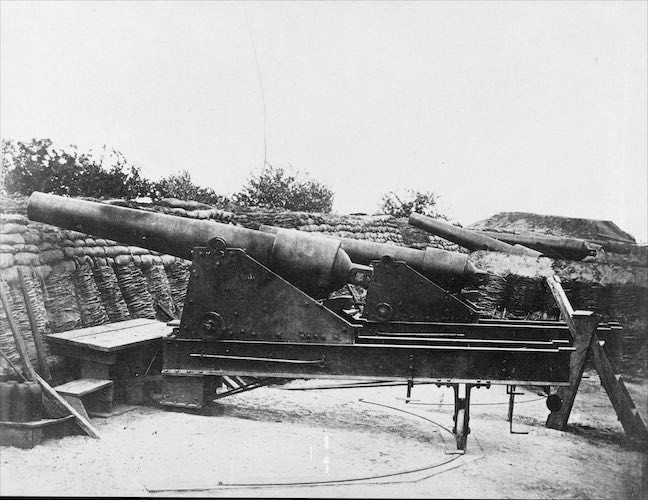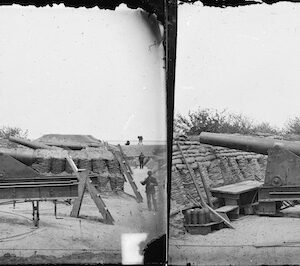| Credit: | by Wood & Gibson |
|---|---|
| Date: | 1862.05 |
| Negative Size: | 8 in. x 10 in. |
| Equipment: | Barbette carriage (front pintle-iron); cannon; gabion; handspike (wood); handspike wrench; ladder; Parrott Rifle gun; Parrott shell |
| Locations & Lines: | Battery No. 1 (Yorktown VA); Yorktown VA; Virginia |
| Military Units: | US Army |
| Sources: | Library of Congress; National Archives |
$6.99
File Details: AIJYm, 800 DPI, TIFF, Original Photograph, 43.9 Mb
Image ID: AIJY
Gardners Photographic Sketch Book Of The War. Vol. 1, No. 12. Battery No. 1, Near Yorktown, Va. May 1862. Battery Number One, before Yorktown, Virginia, 1862. No. 1. When Gen. McClellan undertook to capture the confederate army on the Peninsula by siege, he commenced to construct a line of works from the York to the James river, across the narrow neck of the Peninsula, in front of Yorktown. The first battery was located on the York river, about a mile and a three-quarters from Confederates wharves and their main works in front of Yorktown. It was built by the First Connecticut artillery, Col. Tyler, and had six of the heaviest rifled guns ever mounted in a land battery, namely, one 200-pound Parrott and five 100-pounders. The guns were mounted on heavy wrought-iron carriages, and could only be fired once every fifteen minutes. The muzzles of the guns were about five feet from the ground, and the bottom of the carriages about ten feet below the surface. The dirt thrown out of the excavation was banked up in front of the guns, and kept from falling in by wicker baskets, constructed by the Engineer Corps, and filled with earth. On the top of these were piled bags of sand, and the whole sodded, making an embankment of thirty feet thick in front of the guns. The enemy fired a number of solid shot and shell into this bank from an English sixty-four rifled gun, but none of them did any damage, or entered over ten feet into the earth.
The work was built in a grove of peach trees, on a small promontory which ran out into the York river, and the first intelligence the enemy had of our movements there was a broadside into some of their schooners, which were unloading supplies at the wharf-front of Yorktown, nearly two miles distant. One shot tore through the rigging of a schooner, and another exploded close by, throwing an immense sheet of water into the air over the vessels. In a few minutes they all left, and ran up the York river out of sight. Occasional shots were fired from this battery, at various intervals, up to the time of the enemys departure, but no regular bombardment was ever attempted by it. On riding through the confederate works, the next morning after the retreat, it was found that shells from this battery had fallen two miles beyond their works, or four miles from the battery. Nineteen men were killed and wounded at a distance of three miles by a single shell of the 100-pounders dropping into a confederate camp and exploded before the men could scatter.
An immense magazine in the rear, was connected with the guns by an underground tunnel, through which the men could pass in carrying ammunition. Experienced officers expressed the opinion that with this battery alone, the enemy could have been driven from their position in Yorktown. No lives were ever lost on our side at this battery from the enemys fire upon it.
Library of Congress says: Siege of Yorktown. Federal Battery No. 1, near Farnhold’s house, mounting one 200 pdr. and ten 100 pdr. guns.

